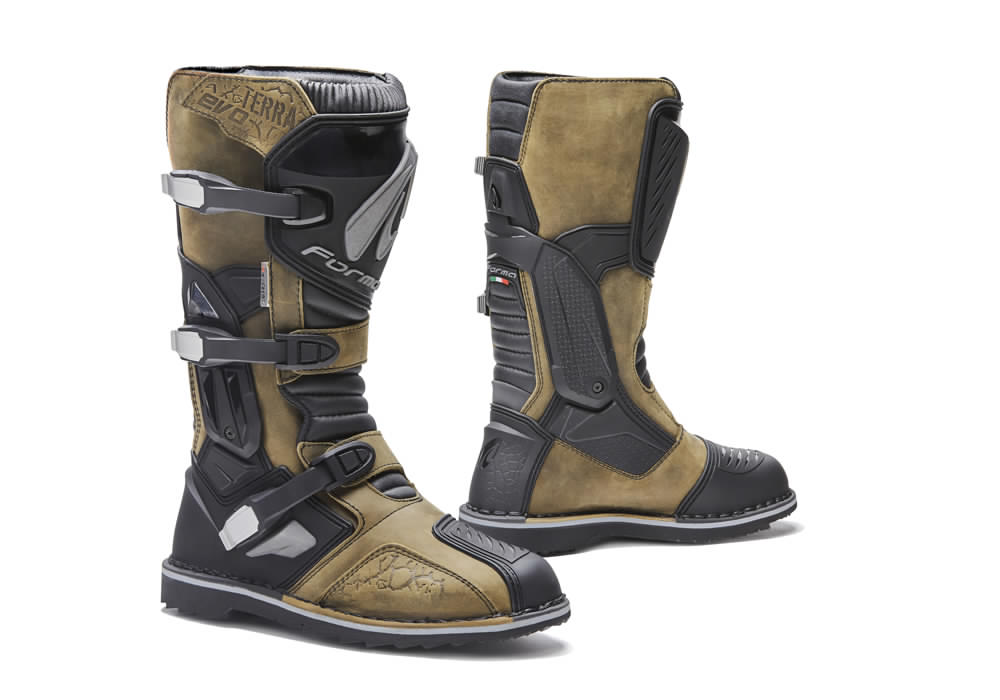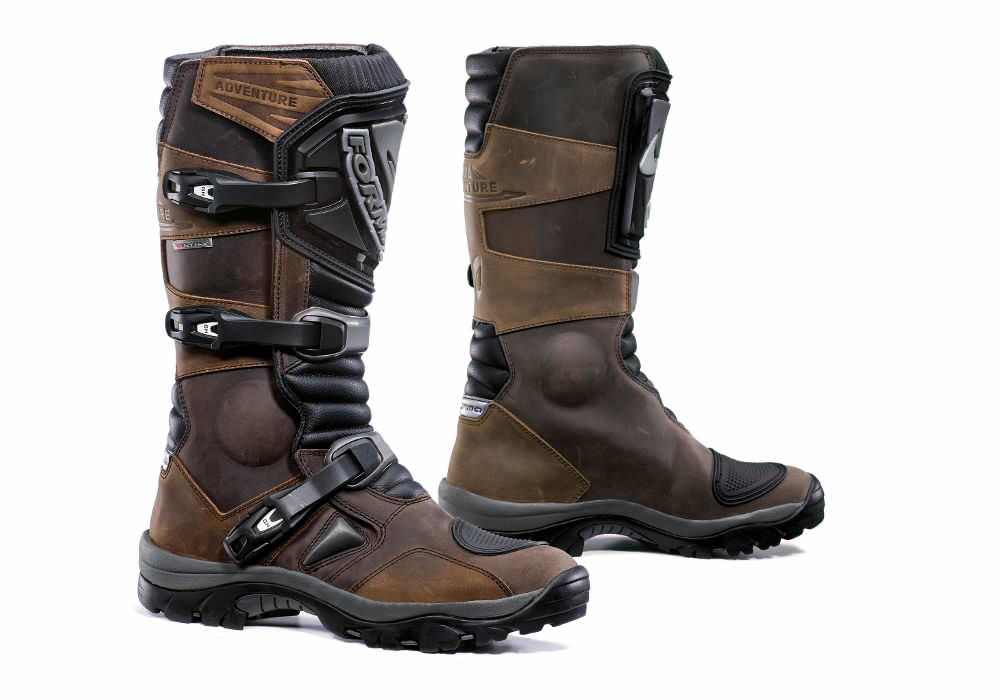Image: Lyndon Poskitt
ATGATT. It’s so simple, yet so many people seem to think it doesn’t apply to them. And part of that important gear that protects us while riding is footwear… namely boots. On this week’s episode we talk with Jim Hyde from RawHyde Adventures and Lyndon Poskitt, three time Dakar racer and world traveller, about adventure motorcycle riding boots, what boots do for us, why we should wear them and what should we consider when choosing our own boots.
According to a study done by Dr Liz deRome, Senior Research Fellow - Motorcycle Safety at Deakin University in Australia - wearing any type of boot provides a 53% reduction in risk of any foot or ankle injury, and a 73% reduction in risk of an open wound injury. But armored motorcycle boots make a much bigger difference in reducing the risk of an open wound injury (90%).
Jim Hyde: RawHyde Adventures
Image: Jim Hyde
Jim Hyde started RawHyde Adventures in the spring of 2002, running an eight day dual sport adventure tour through the Mojave Desert. In 2004 RawHyde started offering an “Adventure Camp” training program. In 2005 they started offering Adventure Rallies and an Adventure Expedition in the Baja Peninsula and Copper Canyon. Soon after, in 2007 RawHyde brought in their training programs and the next year were official endorsed by BMW Motorrad North America and became an official BMW training centre, one of only nine in the world.
RawHyde Adventures has trained thousands of riders, runs tours all over the world, as well as hosts events for adventure riders.
Website: https://rawhyde-offroad.com/
Lyndon Poskitt: Motorcycle Racer and Adventurer
Image: Lyndon Poskitt
Lyndon Poskitt has been racing motorcycles since he was ten years old. He’s raced in the Dakar Rally three times, renowned as the most challenging off-road race in the world. Then in 2013 he had a near fatal training incident that changed how he felt about life. He had dreamed of riding around the world and racing on each of the six populated continents, so he did. He designed and custom built a motorcycle and called his project ‘Races to Places’ and then he documented the journey, releasing over 150 video episodes on YouTube. To date, Lyndon has ridden in 70 countries and raced in 11 competitions during his travels.
Website: https://lyndonposkittracing.com/
Cover Image: Lyndon Poskitt
Anatomy of Adventure Riding Boots
Adventure riding boots offer the protection that you need when you hit the trails, such as protecting your ankles and shins if you go down or get hit by a heavy branch that you didn’t see on the trail. And when you have an off, it’s your feet that usually go down first - be it on dirt or pavement, so you need that protection and the added stability the boots offer.
Boots should be stiff in the ankle area, having molded ankle protection, and have a firm sole to prevent flexing, and the higher the boot the more protection it offers.
The sole of a riding boot is made up of the footbed or insole, the midsole and the outsole. It’s quite rigid, which you’ll notice if you take the boot by the toe and heel and twist it back and forth - there isn’t usually much give - which is good for serious off-roading applications. Some boots have more flexibility - which is good if you do a variety of street and off-road riding.
The footbed, often called the insole is a replaceable contoured piece. To maintain comfort, manufacturers put a shock absorption layer made of Polyurethane or EVA foam in the midsole. EVA is often found in sports equipment and shoes, as well as many other applications, even flip-flops. The material used in the midsole is what also gives it the required flexibility for movement and stiffness for control or safety. And the sole is the bottom of the boot - street riding boots tend to have a smoother sole than adventure riding boots, which often have more aggressive treads - like off-road tires. The more aggressive it is the better for mud and gravel. They’re usually quite thick, often resembling moon boots. The soles are developed to be oil resistant and to have all around good traction.
Riding boots have what’s called a heel cup that helps to keep your foot firmly in place. When you wear stiff footwear, like a pair of shoes that aren’t broken in you tend to get blisters and burns in contact areas such as toes and heels. The heel cup prevents that by stopping your foot from moving up and down when moving around on and off the bike. And it means you have more foot control while riding as well.
The shaft, running up the boot offers protection for the shin at the front of the boot and at the back of the boot it stops the ankle joint from moving side to side or backwards, which can limit mobility especially when walking around.
If you’ve ever worn just regular hiking boots when riding, you’ll probably have noticed the wear marks where your gear lever contacts your boot. Most adventure riding boots have what is called gear shifter pads to protect your boots from damage and wear.
Instead of laces, riding boots normally have quick release buckles - perfect for snugging up the boot, laces don’t get in the way, and they can be removed quickly if needed. The buckles also prevent the boot from loosening up while riding, always providing the maximum protection. And to hold the boots together in the toughest of conditions or an off, manufactures often double or triple stitch the material.
If you do a lot of water crossings or live in an area that sees a lot of rain, you might want to consider boots made with Gore-Tex, Drytex or Sympatex. These waterproof and breathable materials help keep water and rain from soaking your foot and make for a more comfortable ride.
Image: Lyndon Poskitt
Difference Between Adventure Riding Boots and Motocross Boots
Although you might not realize it when comparing adventure riding boots to motocross boots, because in photos they do look quite similar, there are a lot of important differences.
First of all adventure riding boots are lighter than Motocross boots, as much as 2 lbs lighter. That makes for easier riding off-road. Consider exercising with weights in your hands and then without the weights. You get a much bigger work out and tire easier when carrying the weights. Same goes for the boots, you’ll get tired out a lot quicker with heavier boots on, and be much less comfortable.
Adventure Riding boots are usually shorter than Motocross boots, which means less mobility and more difficulty flexing in to good riding positions.
While adventure riding boots are mostly made of leather, motocross boots are mostly plastic - there’s not much give to them. Which means a loss of comfort while riding and also while walking around. The reasons for this are cheaper to manufacture and they can take a lot of abuse while riding faster.
Motocross boots are not designed for all-weather wear - which means they’re usually not waterproof. So, they aren’t good for water crossings or long days in the rain.
There are a lot of motocross boots out there, and you can find them for much cheaper than a pair of adventure riding boots with a much higher selection. And the motocross boots are going to offer the same, if not more protection. You can choose either one - and sometimes a motocross boot might be more beneficial if you’re in to riding trails that present a lot of challenges - rocky climbs and mud holes. But, you will compromise comfort, no doubt.
Buying an Adventure Riding Boot
A couple of important things to consider when buying an adventure riding boot are:
The type of riding you do - Are you riding mostly street or mostly off-road? Do you ride mostly strait and flat or rocky and muddy trails? You might want a versatile all around boot, so you have the support you need when off-road, but you can comfortably walk around to check out the sites or stop at the store on the way home or maybe a more serious off-road boot for hard riding, spending most of the time on your bike.
The fit - different manufacturers sizing and shape design vary greatly. Do you have wide feet? Narrow feet? Leaving a little room might not be a bad idea, because when your feet are in your boots all day long, they tend to swell up when it’s hot out or you might want some room for thick socks (such as Pearly’s, ARR’s official sock) when it’s cold out. You want a snug fit, but you need to be aware that the areas that are armored don’t loosen up with time.
So, put the boots on, walk around, flex your feet this way and that way. Bend down, step up on to objects, step down. Try them with the socks you normally wear while riding. Taking in to account all that we’ve covered on this episode, make a choice that best meets your needs and are a good fit…to boot.
Riding with Forma Boots
Check out the boots that Jim Martin, show host has been testing out from Forma, an Italian boot manufacturer that’s been around since 1999.
Forma Boots: http://www.formaboots.com/
Adventure Boots: http://www.formaboots.com/shop/adventure/
Terra Evo Boots: http://www.formaboots.com/shop/terra-evo/
MUSIC CREDITS:
Title: stinger hiphop
Title: Greasy Wheels
Title: Delta Blues Solo 6
Title: Adrenalin Electronica
Artist: house
Title: Summer Heat (1:05)
Title: BIG CAR THEFT
Title: 90 SECONDS OF FUNK
Artist: Jason Shaw
audionautix.com
Title: human touch feat donnie
Artist: Axel Schwunck
http://ccmixter.org/files/Strauchdieb/49163
Title: drum-bass
Title: rockabilly2
Artist: public domain




